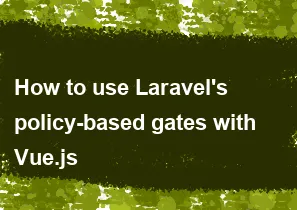How to use Laravel's policy-based gates with Vue.js

Laravel's policy-based gates are typically used on the server side to authorize actions. If you want to integrate policy-based gates with Vue.js, you'll likely need to make some Ajax requests to the server to check the policies and then conditionally render or allow actions on the client side. Below are the general steps you can follow:
Define Policies in Laravel:
- Create policies using
php artisan make:policy PolicyNamecommand. - Define methods in the policy to check for authorization.
- Create policies using
Create an API Endpoint:
- Create an API endpoint in Laravel that checks the policy using the policy class and method.
- This can be done in a controller method.
Make AJAX Requests from Vue.js:
- In your Vue.js component, make AJAX requests to the Laravel API endpoint.
- You can use Axios or the native Fetch API for this purpose.
Handle Responses in Vue.js:
- Handle the responses from the server in your Vue component.
- Depending on the response, enable or disable certain features or UI elements.
Here is a simplified example to illustrate the concept:
Laravel Side:
php// UserController.php
public function edit($id)
{
$user = User::find($id);
$this->authorize('edit-user', $user);
// The user is authorized to edit, proceed with the edit logic
// ...
}
Vue.js Side:
html<!-- Vue Component -->
<template>
<div>
<button @click="editUser">Edit User</button>
</div>
</template>
<script>
export default {
methods: {
editUser() {
const userId = 1; // Replace with the actual user ID
axios.post(`/api/check-edit-user/${userId}`)
.then(response => {
if (response.data.authorized) {
// The user is authorized, proceed with the edit
this.$router.push(`/users/${userId}/edit`);
} else {
// Show an error message or handle unauthorized access
console.log("Unauthorized access");
}
})
.catch(error => {
console.error(error);
});
}
}
};
</script>
Laravel Side (API Endpoint):
php// ApiController.php
public function checkEditUser($id)
{
$user = User::find($id);
// Check the edit-user policy
if (Gate::allows('edit-user', $user)) {
return response()->json(['authorized' => true]);
} else {
return response()->json(['authorized' => false]);
}
}
Remember to configure your routes and middleware appropriately. This is a basic example, and you might need to adapt it based on your specific use case and application structure. Additionally, consider securing your API endpoints and handling authentication properly.
-
Popular Post
- How to optimize for Google's About This Result feature for local businesses
- How to implement multi-language support in an Express.js application
- How to handle and optimize for changes in mobile search behavior
- How to handle CORS in a Node.js application
- How to use Vue.js with a UI framework (e.g., Vuetify, Element UI)
- How to configure Laravel Telescope for monitoring and profiling API requests
- How to create a command-line tool using the Commander.js library in Node.js
- How to implement code splitting in a React.js application
- How to use the AWS SDK for Node.js to interact with various AWS services
- How to use the Node.js Stream API for efficient data processing
- How to implement a cookie parser middleware in Node.js
- How to implement WebSockets for real-time communication in React
-
Latest Post
- How to implement a dynamic form with dynamic field styling based on user input in Next.js
- How to create a custom hook for handling user interactions with the browser's device motion in Next.js
- How to create a custom hook for handling user interactions with the browser's battery status in Next.js
- How to implement a dynamic form with dynamic field visibility based on user input in Next.js
- How to implement a dynamic form with real-time collaboration features in Next.js
- How to create a custom hook for handling user interactions with the browser's media devices in Next.js
- How to use the useSWRInfinite hook for paginating data with a custom loading indicator in Next.js
- How to create a custom hook for handling user interactions with the browser's network status in Next.js
- How to create a custom hook for handling user interactions with the browser's location in Next.js
- How to implement a dynamic form with multi-language support in Next.js
- How to create a custom hook for handling user interactions with the browser's ambient light sensor in Next.js
- How to use the useHover hook for creating interactive image zoom effects in Next.js